




Over the last decade Guernsey’s public spending has risen faster than its economy has grown And its economy has grown at a slower rate than was expected This has had an impact on the structural fiscal position and will have an impact on that position going forward.
Spending pressures driven by demographics already put strains on the fiscal regime. This situation of continuing weak growth makes the future even less affordable Population, productivity and fiscal drag have all contributed to lower-than-expected growth As a result the burden of taxation on individuals has already increased significantly since the introduction of zero/10.
A recognition of these facts is missing from Guernsey’s review of taxation. Consequently, an attempt to understand their impact and causes is also absent Our view is that the proposals set out in the tax review are unsustainable because the thinking that went into the review did not include consideration of these broader economic issues.

As a result, we suggest that GST of 10% or even 15% will be needed to balance the books by 2040
We are not against GST in principle, consumption taxes are economically efficient We set the outline of an alternative approach in this document. GST is part of that approach.
The tax review process should have afforded the opportunity to radically alter the tax regime to improve competitiveness and sustainability of the regime
it is our view that the introduction of a flat tax regime will provide the boost to competitiveness the Guernsey economy requires One single rate of tax on personal income, corporate income, social insurance (combined) and, yes, GST.

Combined with a territorial corporate tax regime, it would create a sustainable tax regime for the long run
We sincerely hope that Guernsey's politicians consider the contents of this report and give pause to their deliberations to fully assess the opportunity to introduce such a regime
Finally, fairness is a notoriously subjective issue. Even so, Guernsey's tax review seems to adopt a very narrow view of fairness. We would have thought it perfectly reasonable for all in society to be asked to make a contribution to higher costs of public services And with the obvious focus on compensating lower income groups for higher prices due to GST, no thought seems to have been given to addressing issues of intergenerational equity.
And we find it perverse, given the demographic catalyst of the review, that of all groups, higher income working families and single parents are by far the worst hit by the proposals The tax regime should support families and single parents, not penalise them We believe that Guernsey's Policy and Resources Committee's original proposals should have included the introduction of a generous tax allowance for children.
Since 2009 (the year after both the global financial crisis and the introduction of zero ten corporate tax regime in Guernsey), growth in the Guernsey economy has been poor. It has averaged just 0.5%pa.
Average growth has even lagged the UK, an economy with several structural growth issues of its own This suggests to us there is something problematic with the workings of Guernsey’s economy
We need not look far to be provided with an explanation.
The finance sector, the mainstay of the Guernsey economy, the driver of economic growth from the 70s to the 00s, shrank between 2009 and 2021, falling from a GVA (gross value added) of £1 358bn in 2009 to a GVA of £1 243bn in 2021 As a share of the Guernsey economy, it fell from 42% in 2009 to 36% in 2021. The issue of secular decline raises its ugly head.

During this same period, public spending growth continued, averaging 2% pa. Guernsey's Policy & Resources Committee clearly presumes a continuation of this trend, expenditure is illustrated in its Policy Letter as rising by 26% in real terms from 2011 to 2025 Broadly 2% pa
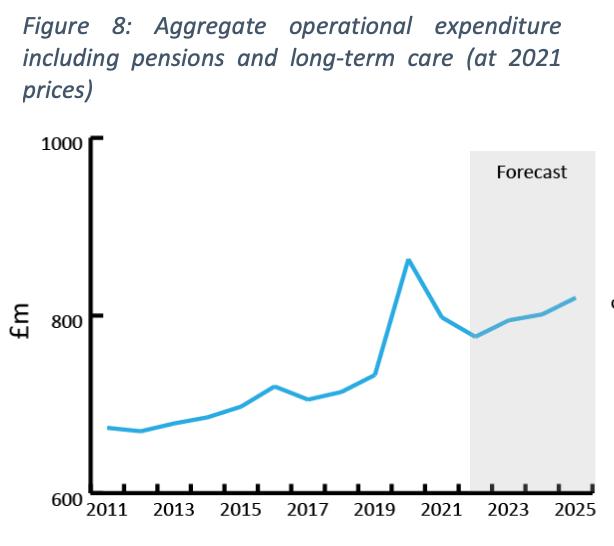
This rate of growth is not in itself excessive. Indeed, given the demographic pressures on health and pensions spending, it suggests some degree of expenditure restraint elsewhere. We will consider some of the components of this spending in a later section
All things considered, spending growth of 2% would be sustainable with economic growth of 2%. Revenues would rise at the same rate as spending with no need to revise tax regimes. But actual growth rates in the economy have averaged just over ½ a percent.
Unless something is done to improve economic growth public spending is one an unsustainable path
Nothing in the proposals of the tax review addresses this issue of weak economic growth, nor factors its impact on the fiscal position into any analysis.
That this has been overlooked probably arises as the exercise undertaken by Guernsey's Policy & Resources Committee has focussed on a static balancing of the books
Public spending is projected to continue a trend growth of 2% per annum.
But public spending has been growing faster than underlying economic growth, resulting in a rising tax burden.
The consequences of this situation are stark The affordability of increased spending becomes much more difficult and must be funded by increased taxation. The overall burden of taxation increases.
For example, if spending grows one percentage points more than the economy, then over a ten year period an extra ten percent of revenue must be raised by the same tax base The process is often not transparent Allowances are frozen, rise less than inflation, or are just removed and other taxes and fees increase at rates much faster than inflation.


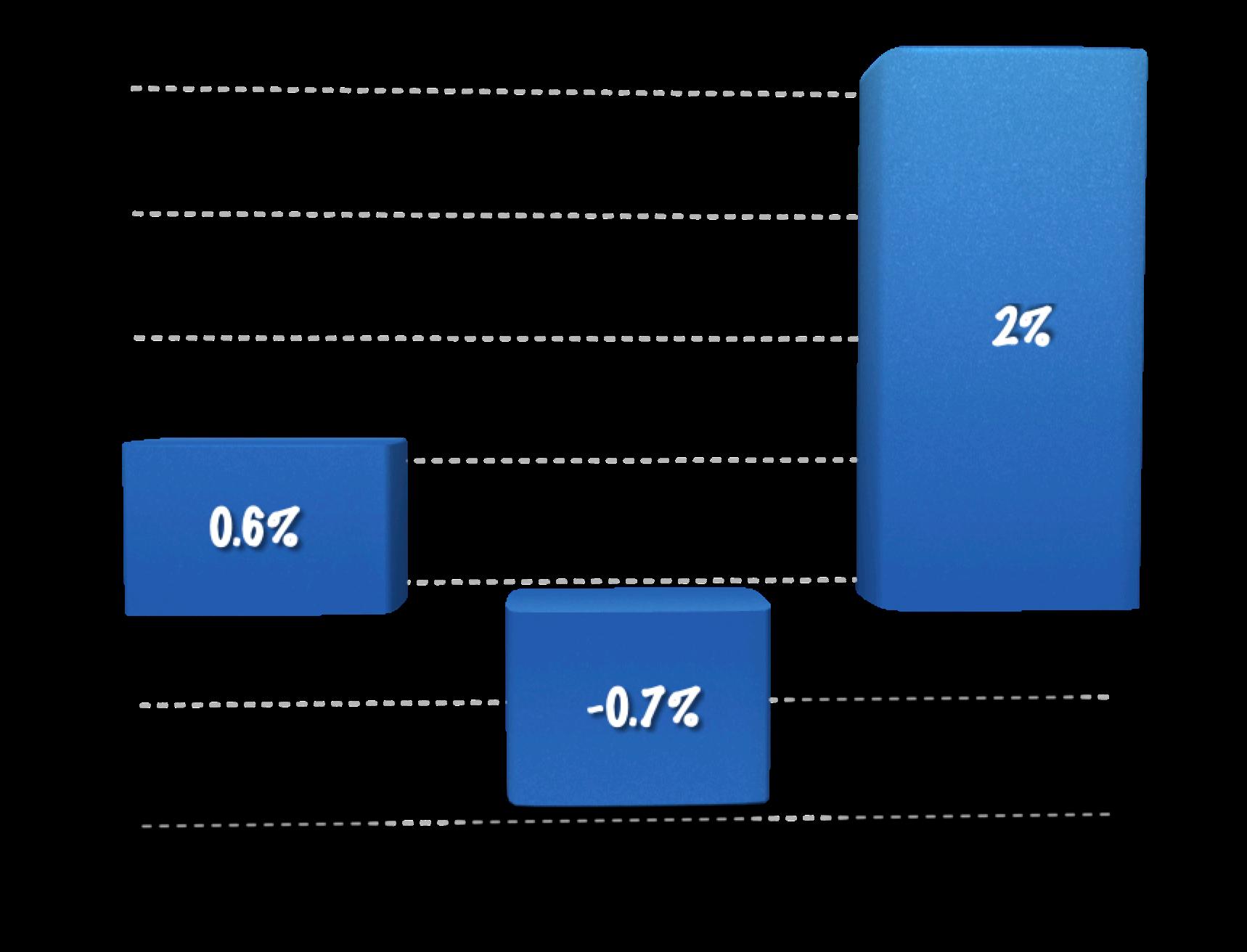
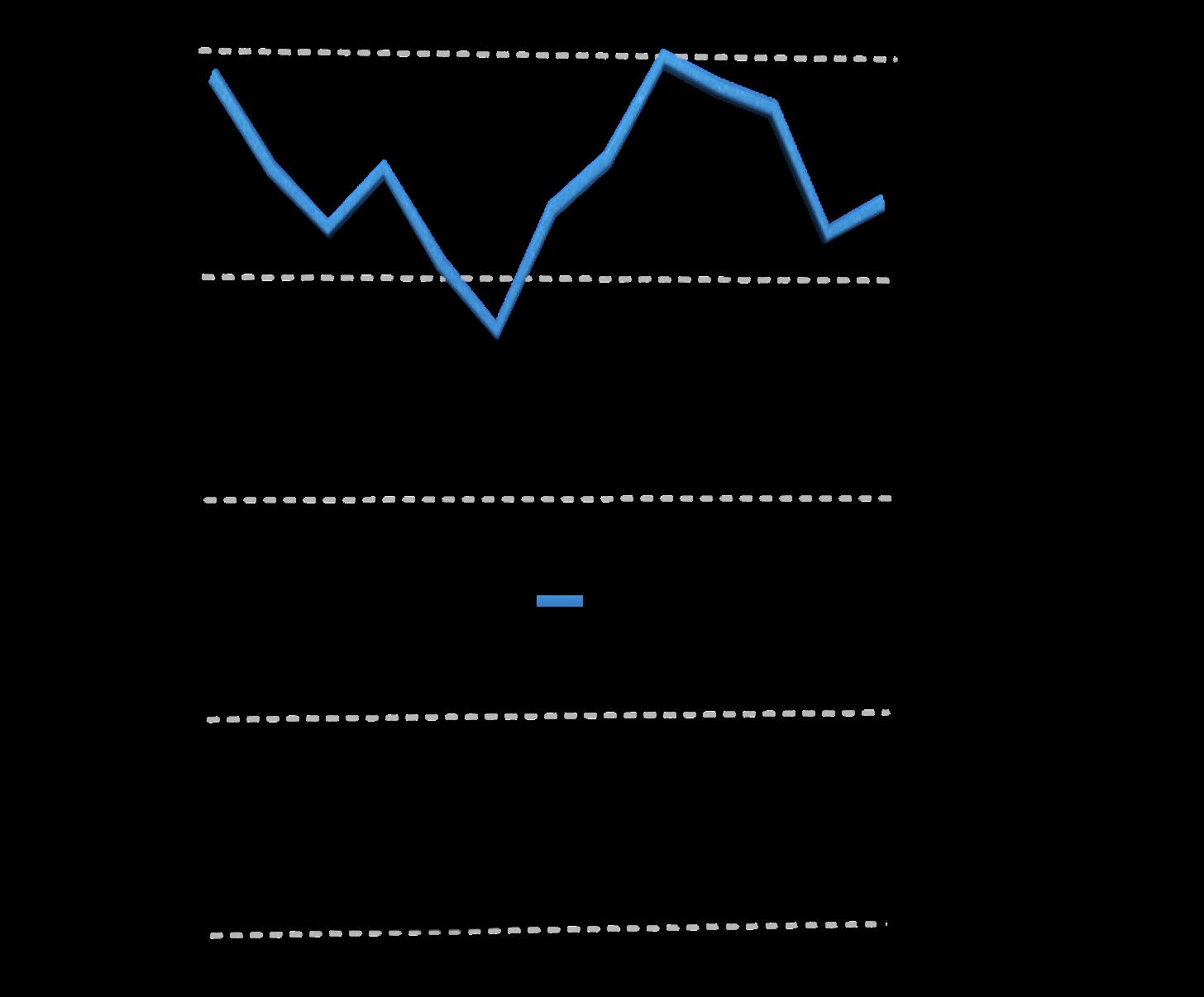

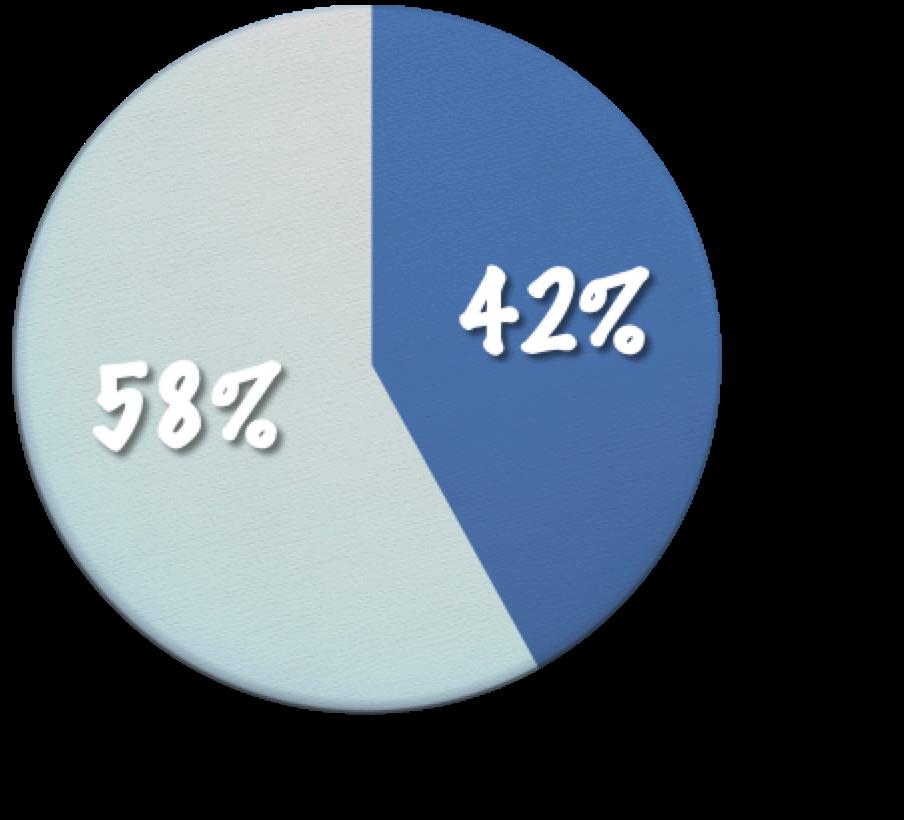


This has broadly been Guernsey's experience of the last decade A continual fiscal tightening has been applied through the course of ten years to the detriment of the economy
Guernsey government s departmental operating income (broadly fees and charges) rose from £26.4m in 2008 to £64.2m in 2021. These figures are nominal, that is before the impact of inflation is taken into account. Allowing for inflation over the period, the rise is around 75% in real terms Not an insignificant increase at the macro level, from just this one line item, adding to the aggregate tax burden on individuals
We calculate that the overall burden of taxation on individuals, that is personal taxes and social insurance, excise duties and other indirect taxes paid by individuals, and fees and charges, rose by 18% in real terms between 2008 and 2021
A rise of nearly one fifth This is without any new taxes and no changes in headline rates
...
the finance sector has shrunk in relative and absolute terms



Understanding the impact on growth of population and productivity is central to understanding the causes of any loss of economic growth This is as relevant to the economy overall as to the finance sector Output is basically a function of workers and their productivity. Each worker produces a set amount. Their productivity. Efficiency and technological improvements result in productivity growing over time. But a growing population or workforce is another source of growth If the number of workers increases, then the increase in economic output is their number times their productivity
Historically Guernsey experienced growth of its population pretty much continually throughout the 20th Century (two World Wars aside) and indeed it was routine for actuarial projections of the sustainability of social insurance funds to include an assumption of a trend growth rate in the population This assumption was carried over into Guernsey's Policy Council's 2012 report on long term cost pressures of public services
Analysis demonstrates that historically, population growth accounted for 25% of Guernsey s economic growth with productivity gains contributing the other 75%.

By deductive logic, if the workforce of the finance sector stops growing, half a percent per annum of growth is immediately lost, all other things being equal
Guernsey's population growth stopped abruptly in 2011 and subsequently fell The States decreed at the end of 2007 that population levels should be held at levels then prevailing. Whilst the legislation to create a new regime took many years to introduce, it is our contention that, with a degree of lag, Guernsey's Housing Department of the time administered the old regime with an objective of population control It was not until the late 2010s that political opinion on population growth thawed and the administration relaxed accordingly
Whatever the reason, population growth came to an abrupt stop in 2011, and then fell. Levels would be around 2000 more today (and the workforce some 930 larger) if trend growth rates had continued.
The historic analysis from Guernsey's Policy Council (presented at the GFSC annual update in 2012) demonstrates the finance sector accounted for all net employment growth between 1997 and 2011
Historic analysis demonstrates that all employment growth between 1997 and 2011 was accounted for by the finance sector.
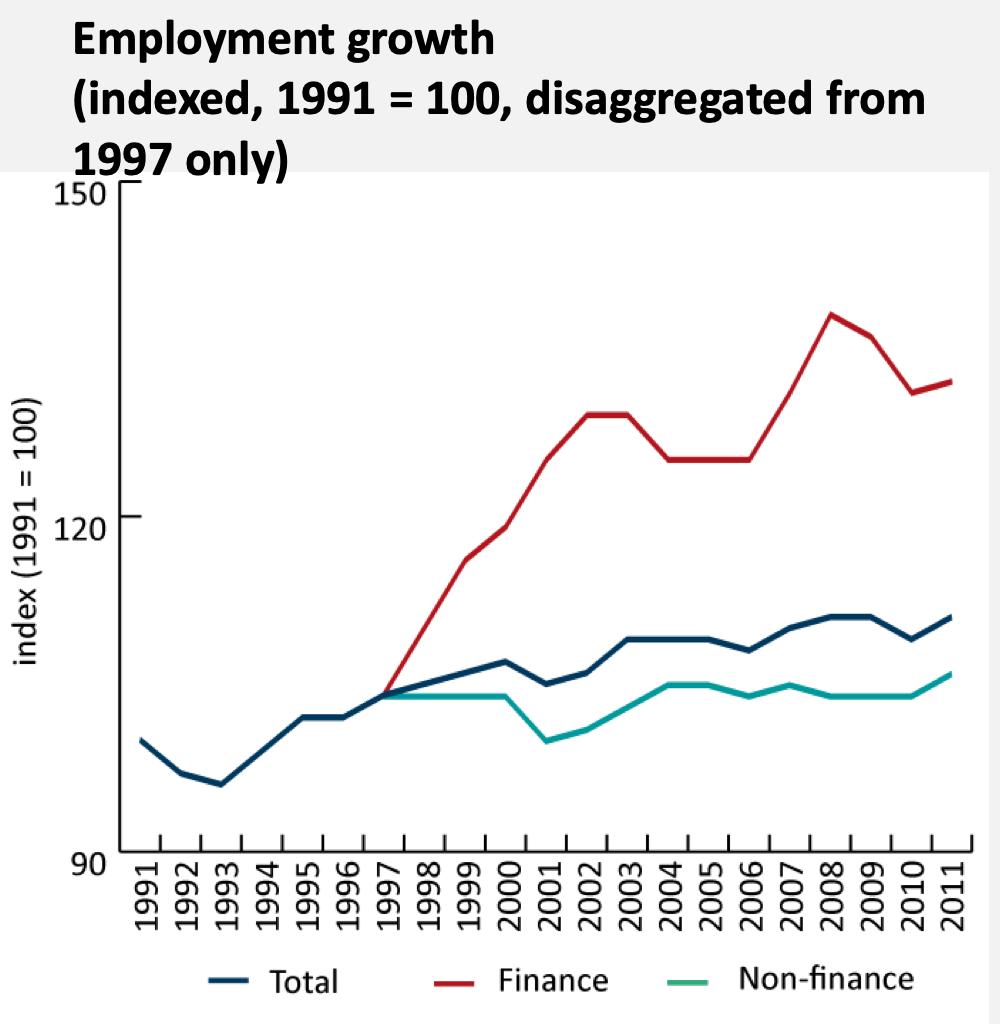


Whatever fell first, supply or demand, the counterfactual (what might have otherwise happened) is that population levels were some 2000 less than they would otherwise have been in 2021 had population growth continued. The result of the workforce being commensurately smaller1 was a negative hit to GDP of around 3%
This fall in workers together with a the fall in productivity growth, which we estimate to have been around 1% pa, over the period results in a level of output that was some £350m lower than it would have otherwise been in 2021.
This is not a completely innocuous point. £350m more GDP translates to another £70m in government revenues. More than covering the estimate of the current deficit of overall public revenues to public spending
In addition to structural factors that might be at play, previous tax rises are likely to also have had an negative impact on growth
Taxation does not occur in a vacuum, it occurs within an economy and whilst taxation might well be income for governments it is a loss of income for individuals. The burden of taxation on individuals increased by some 18% between 2009 and 2021, around £90m in 2021 money.
An, admittedly simplistic, text book treatment of calculating the hit to output from increased taxes is to multiply the tax increase by the Keynesian tax multiplier2 to provide a general idea of the potential scale of the impact of these tax rises
This tax increase did not all happen at once, it is the accumulation of rises made by stealth across the years. For the purposes of crude analysis, we assume a straight-line increase We arrive after just a little arithmetic at an annual hit of around 0 9% Being generous, let us halve this and round down to give us an estimate of the hit to growth of 0 4% per annum Granted it is just a simple model and could well still be an overestimate, but it demonstrates a point. It is clear to us that there would have been a detrimental effect on growth from ten years of gradual fiscal tightening that has never been incorporated into policy thinking
The combined impact of all these various factors is difficult to ascertain and requires a much greater level of modelling This quick exercise was merely to provide estimates of the scale of potential impact of each factor.
1 Concurrent y, work ng age numbers e by around 1100 due o demog ap cs
.....the counterfactual: Guernsey's economy is some 11% lower than it would have otherwise been if trend growth rates in productivity and population had continued
Demographics drive the two biggest long term upwards pressures on Guernsey's public sector costs. An ageing society means more pensioners, and those pensioners are tending to live longer and draw their pensions longer thus increasing cost. Society's ageing tendency also increases health and social care costs. An ageing population consumes more healthcare and social care
The same demographics result in a shrinking share of the population at working age. This fell by 3% between 2011 and 2021 Thus these increased costs are being 'shared' amongst fewer workers Each worker pays more
In 2012 Guernsey's Policy Council published a report on pressures on public sector costs. The purpose was to demonstrate the impact of these uncontrollable demographics on spending pressures (costs) The report showed how these varied with different outcomes for population, economic growth and, with respect to healthcare, different rates of rising relative costs (healthcare inflation).
This exercise demonstrates that at some point spending becomes unsustainable A commitment to the best healthcare for all is laudable, but at what cost? 5% of GDP? Fine. 10% of GDP? Perhaps OK. 15%? 20%? 25%? There will be a limit somewhere. Thus over time, it will be necessary to reduce access to certain treatments.
Even with economic growth, demographics results in rising health care costs.
We reproduce below FTE numbers and salary bill costs of healthcare and medical staff from 2011 to 2021 Salary bills are reflated to 2021 values (ie to take inflation into account).
Even allowing for COVID, a rise of 78% in ten years for the salary bill for health is difficult to comprehend Understanding in full the causes of the rapid rates of growth going forward are outside of the scope of this paper, but the government projection we reproduced does not seem to incorporate any post COVID drop.
Controllable costs being that those due to the increase in the rates of payment It determined that between 2001 and 2011 there had been an increase in real terms (ie taking account of inflation) of 40% in pensions expenditure due to rising rates of pension benefit.
No such analysis exists for the last ten years This is not an unimportant exercise When the burden for more and more pensioners is being shared between fewer workers, generous rises above the price level bring risk of an unsustainable burden.
We reproduce one of the examples from the 2012 report Total healthcare costs were projected to rise by between 2 2% and 3 1% of GDP over the forecast period (2010 to 2040), given assumptions of economic growth of 2% and 2% healthcare inflation. This was not a forecast but a projection of the as is, as was then (in 2012), situation.
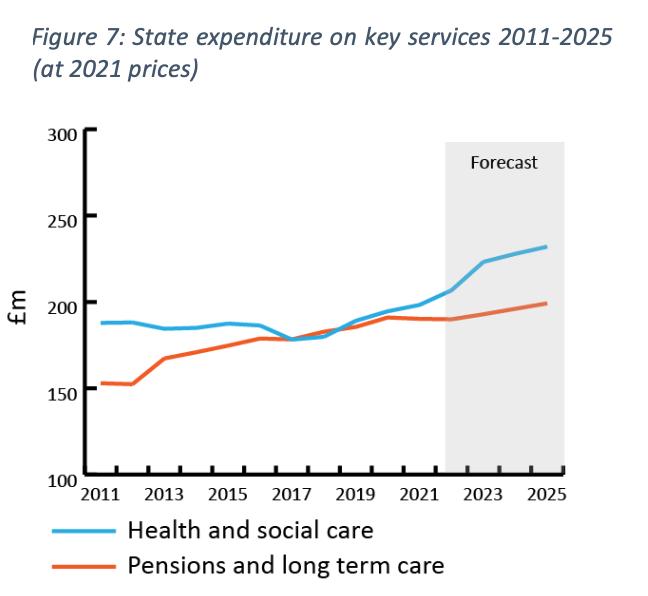
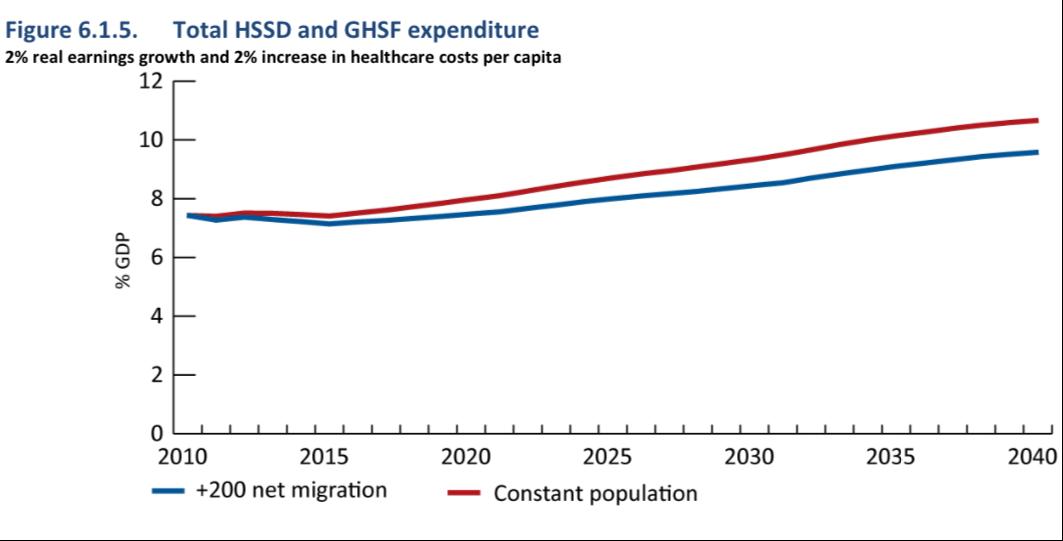
Guernsey's tax review demonstrates the actual rise in healthcare costs over the last ten years and projects its rise to 2025. As can be seen, in a similar manner to the 2012 projections, the rise is steady at first, but then increases to a rate much faster than either of the two scenarios presented in the 2012 report We extrapolate forward this rate of growth which rises to levels of expenditure on healthcare of 15 6% of GDP by 2040 This is not sustainable
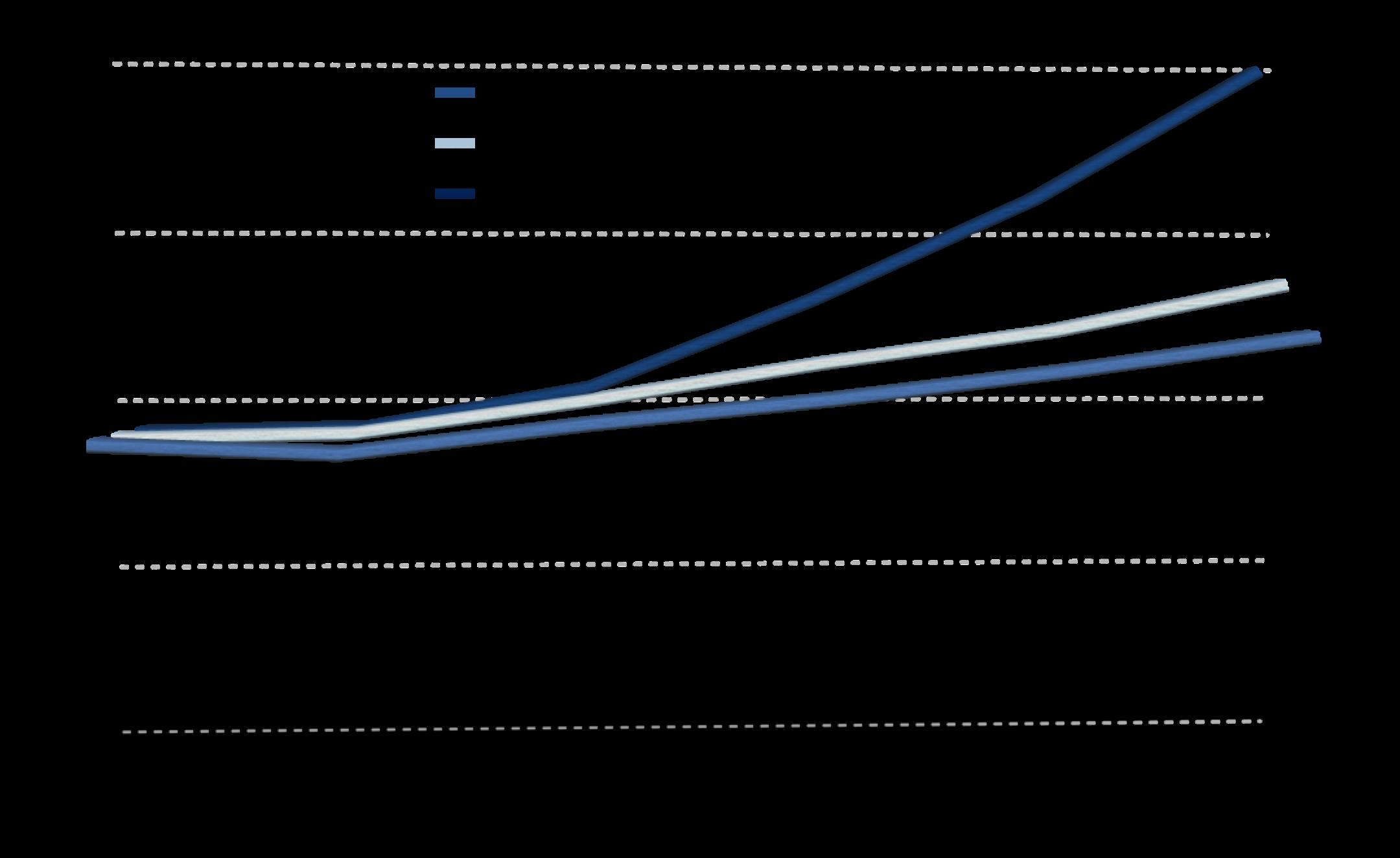
Staff FTEs Salary (£m)
2011 929 44.2

2012 942 49.0 2013 946 48.8 2014 958 49.0 2015 1001 55.3 2016 1007 55.3 2017 1028 56.5 2018 1092 59.3 2019 1151 67.3 2020 1256 72.5 2021 1380 78.5
Even allowing for COVID, there has been a steadily increasing rise in staff numbers and the salary bill over the last ten years.
Demographic pressures are pretty much unavoidable Which is why it is so important to avoid increases in controllable costs in other areas Guernsey's 2011 Fiscal Framework report3 provided an analysis of the rising pension expenditure broken down into controllable and uncontrollable costs. Uncontrollable costs being those due to increasing numbers of claimants (once future beneficiaries are defined there is no control of how many can claim)
The UK has found to its cost the dangers of being overly generous with its triple lock promise to pensioners. There are intergenerational equity issues to consider too. For example, current pensioners paid much less into the regime that present day taxpayers
Similarly, whilst the debate around income support is fraught with emotional politics, at the end of the day, the state is taking income from one individual or family, and giving it to another. Payment of income support has more than doubled in cash terms since the previous system was 'modernised' in 2014
It is not heartless to warn of the dangers of generous benefit increases. The state has a duty to guard against overburdening the taxpaying public

We believe that the States of Guernsey has a structural deficit We believe too that the low rate of underlying economic growth over the last decade (driven by poor finance sector growth, population control and fiscal tightening) has contributed to the size of that deficit. We have shown that productivity and population could have combined to worsen the overall position by some £70m
We dislike the method of calculation of the structural deficit presented in Guernsey's Policy & Resources Committees'4 Policy Letter and use our own method based on an economic treatment
We utilise the simple presentation of aggregate revenues from 2021 (the most recent audited accounts) and select the relevant income and expenditure lines as explained below As can be seen we arrive at a structural deficit of around £50m The large balance in the social insurance funds provides a draw-down facility that enables this imbalance to continue for some time We include actual capital expenditure but understand the rationale of trying to account for the revenues associated with long term average expenditures in a calculation of the structural position.
As this figure of £50m is broadly similar to the 'immediate revenue raising target' set out by Guernsey's Policy & Resources Committee, we are satisfied in using our preferred methodology as the basis for developing our own set of projections of the fiscal position arriving in 2040.
The date of 2040 is not arbitrary it is the date by which the baby boomer bulge is forecast by actuaries to have washed through the system and the worst of the funding issues caused by demographics should be over.
Our selected lines are coloured. Green for income. Red for expenditure. We are only interested in the underlying structural position. Thus we look at income (real income) and expenditure only We ignore various accounting lines such as financing, transfers and investment returns. We do not agree with the practice of presenting an improvement in the valuation of assets in investment funds as income

We also ignore investment returns of the social security funds for the same reason. We would, however, include dividend income, if reported, of those funds as a temporary revenue stream
For our projections we have broadly incorporated a path for future revenues and expenditures based broadly on a continuation of present trends. That is a continuance of low rates of economic growth and public spending continuing at its seemingingly trend growth rate of 2% We did not incorporate the potential runaway rates of health care expenditure growth discussed in the previous section
A key concern we have is that there has been a lack of consideration given to poor economic growth rate of the last ten years and the impact on the fiscal position We do not see any evidence in the review process that this economic issue is understood as a contributory factor to any fiscal problems.
Our projections demonstrate a key risk of the proposed approach

Our projection of the 2040 fiscal position based on a continuation of present trends results in an underlying deficit rising to over £200m We calculate that with no other changes a 15% GST rate would b required to balance the 2040 fiscal position
2021
Tax revenues (£m) 472

Operating income (£m) 64

Other corporate income (£m) 38
Gross revenue expenditure (£m) (537)
Operating surplus / (deficit) (£m) 37
Finance charges and other costs (£m) (37)
Investment returns (£m) 83
Transfers to other entities (£m) 17
Capital receipts (£m) 1
Capital expenditure (£m) (40)
Overall surplus / (deficit) (£m) 61
Social Security contributions income (£m) 191
States grant (£m) 17
Social Security Funds expenditure (£m) (241)
Social Security Fund investment returns (£m) 99
Social Security Funds surplus / (deficit) (£m) 66
Aggregate income (£m)* 948 765
Aggregate expenditure (£m)* (820) (818)
Aggregate surplus (deficit) (£m)* 128 (53)
We provide projections of the future deficit under different scenarios for illustration One where a higher growth rate of 1 5% per annum is achieved One where revenue spending growth (not social spending) is limited to 1% per annum growth Rates of 10% GST are required under both scenarios to balance the books. Only achieving both, a highly implausible scenario given recent historic experience, enables GST to remain at 5%.
Our modelling convinces us that GST will rise to at least 10% by 2040 under the current proposals.
Projecting forward present spending and economic growth rates suggests a rate of 15% GST would be required to balance the books.............only both improving growth and controlling expenditure avoids the need for a 10% rate of GST in 2040.
There are two main arguments deployed by those who oppose the introduction of GST in the Guernsey tax debate. The first is that it is regressive, in that those on lower incomes pay more
Our view is that if more egalitarian societies than Guernsey such as France and Sweden can live with GST and at rates of 20% and 25% respectively, then the argument is just a convenient diversion
In theory it is clearly regressive, but to a point. Once introduced the variable of interest is whether incomes keep track of inflation to maintain living standards A fixed rate of GST has no impact on this Clearly Guernsey's Policy and Resources Committee have bought into this argument because they have gone to extreme lengths to ensure lower income groups are not adversely impacted by the introduction of GST at 5%
We believe we are justified in using the word extreme. There seems to have such a focus on this one consideration To the point that the fairness of asking just the highest 30% income group to shoulder the burden of all the costs of increased demographic pressures at the same time as as funding a tax reduction for the majority of the population seems to have been overlooked.
No thoughts are expressed about addressing generational inequities and one of the most perverse results of this narrow approach to fairness is the rather painful situation where higher income working families and single parent households suffer the highest tax burden. To us, it is quite astounding that those who are asked to contribute the most to the funding shortfall driven by ageing demographics are those physically doing their bit (ie having children) to improve those demographics
Families and single parents should be supported by the tax system not penalised by it The reinstatement of a generous family allowance to all income groups should have been part of Guernsey's Policy & Resource Committee original proposals.
The second argument deployed is that the introduction of GST at 5% is nothing more than a precursor to the introduction of GST at 10%. We have sympathy with this argument
As we demonstrated in the previous section, unless something is done to improve the growth rate of the economy, a rate of at least 10% of GST will be required to balance the books by 2040
The Guernsey government has increased the tax burden on individuals by 18% in recent years. It does not require a leap of faith to believe they will be minded to double the rate after its introduction to balance the books

That Jersey has not yet raised GST to more than 5% is not a cause for comfort They raise more revenue from income tax as a share of revenue, despite having GST, presumably because of the success of '20 means 20' their key fiscal tightening measure post zero/10.
Notwithstanding, Jersey is operating a structural deficit of more than £100m. An unsustainable position.
Families and single parents pay most under Guernsey's Policy & Resource's Comittee's proposals.


One of the key arguments deployed by the supporters of GST in the tax debate in Guernsey is that the introduction of GST will broaden its tax base. Guernsey is too dependent on income tax goes the argument. But introducing GST at just 5% does not provide a truly significant improvement of the balance between methods of taxation


After the introduction of GST, the distribution is far short of the more balanced UK system. This anomaly feeds the suspicion that a 10% rate is a likely outcome in time.
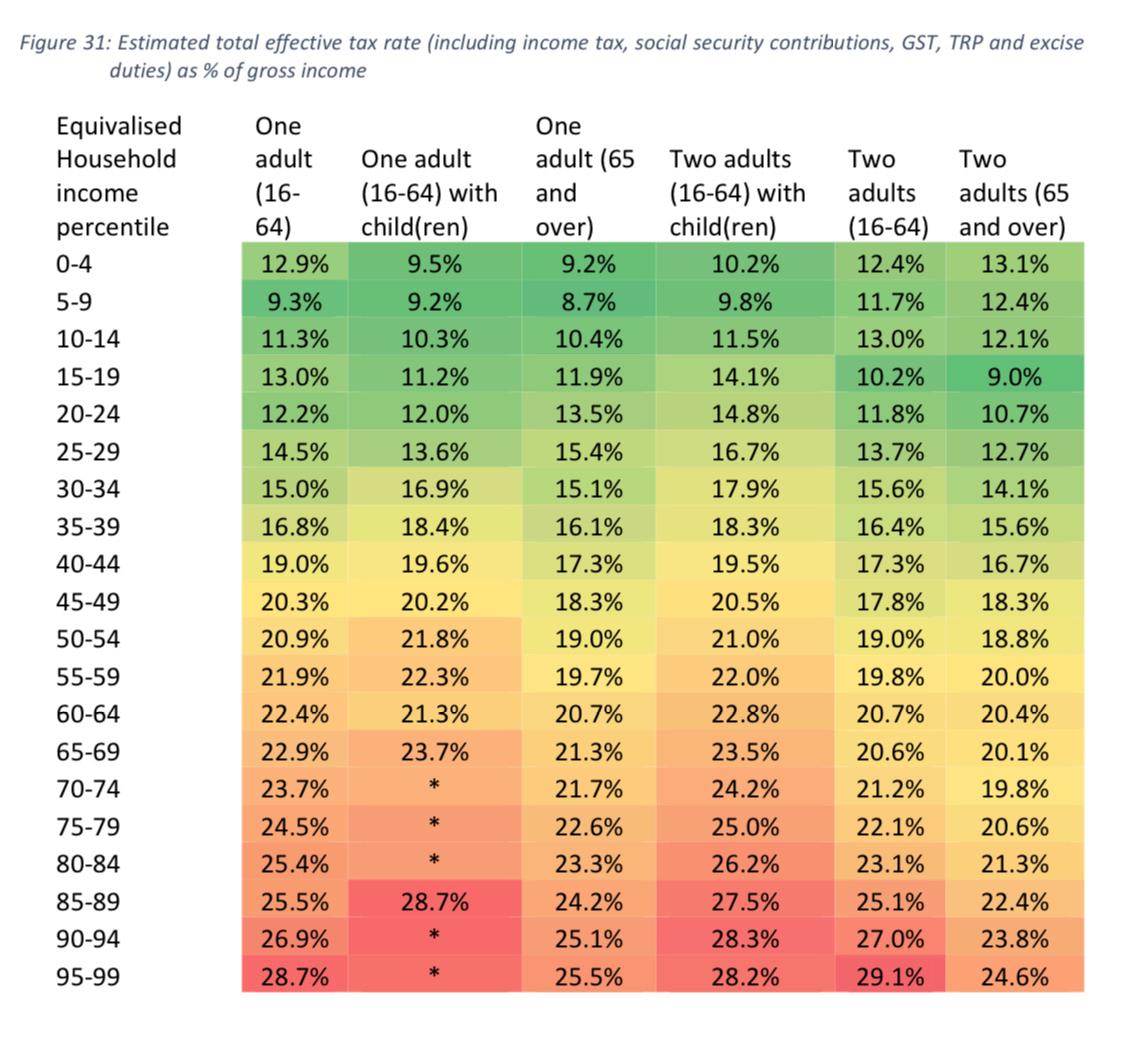
Finally, whilst there is much discussion of the inflationary impact of the introduction of GST, its impact on economic activity is rarely mentioned.
We discussed the contractionary effects of tax rises in an earlier section A Keynesian multiplier approach would be appropriate to estimate the scale of the economic impact of a one off £60m tax rise. It implies a contraction of £240m. Our instinct is that is too high an estimate but clearly a negative impact will manifest.
Those whose tax bills rise most will also most likely be those hardest hit by recent increases in interest rates. There is nothing that suggests the impact on those households facing rising mortgage costs has been factored into thinking. The proposed timing of introducing GST is not auspicious
For the reasons explained, we strongly suspect that the current proposals of Guernsey's Policy and Resources Committee if approved, will lead to 10% GST, even if that is not the current intent
Our central issue with the proposals is that no consideration is given to the fiscal impact of the poor growth rates experienced by Guernsey since 2009 Continued public spending growing annually at 2% alongside economic growth of 0.5% pa is not a sustainable position. Introducing GST on its own does nothing to change that, indeed by removing another £60m of expenditure from the economy, it likely worsens the economic picture.
In our view there is nothing in the proposals to bring about any improvement in Guernsey's economic competitiveness. The process has clearly been one with an exclusive focus on raising revenues by a given sum.
This tax review provides an opportunity to radically restructure Guernsey's tax regime to achieve more than just a balancing of the books. There is an opportunity to boost competitiveness and help set Guernsey's economy on much needed higher growth path and put public finances back on a sustainable path
Our proposal is regime which includes GST. A regime where all major taxes, personal income, corporate income, social insurance, and GST are all set at the same rate
A flat tax regime.
Of 12.5%
This would be a major pro-growth move. Alongside revising the corporate tax regime.
Introducing such a regime at anytime would send a major signal to the world about the seriousness of Guernsey to improving the competitiveness of its economy.
In the global policy consensus of today, it would be a stand out move, conveying a commitment to improving economic growth which is presently absent

A flat rate of 12 5% would attract investors
A flat tax of 12.5% raises the same amount of revenue as the present regime.
CURRENT REGIME 2021
Tax revenues (£m) 472
Operating income (£m) 64
Other corporate income (£m) 38
Gross revenue expenditure (£m) (537)
Operating surplus / (deficit) (£m) 37
Finance charges and other costs (£m) (37)
Investment returns (£m) 83
Transfers to other entities (£m) 17
Capital receipts (£m) 1
Capital expenditure (£m) (40)
Overall surplus / (deficit) (£m) 61
Social Security contributions income (£m) 191
States grant (£m) 17
Social Security Funds expenditure (£m) (241)
Social Security Fund investment returns (£m) 99
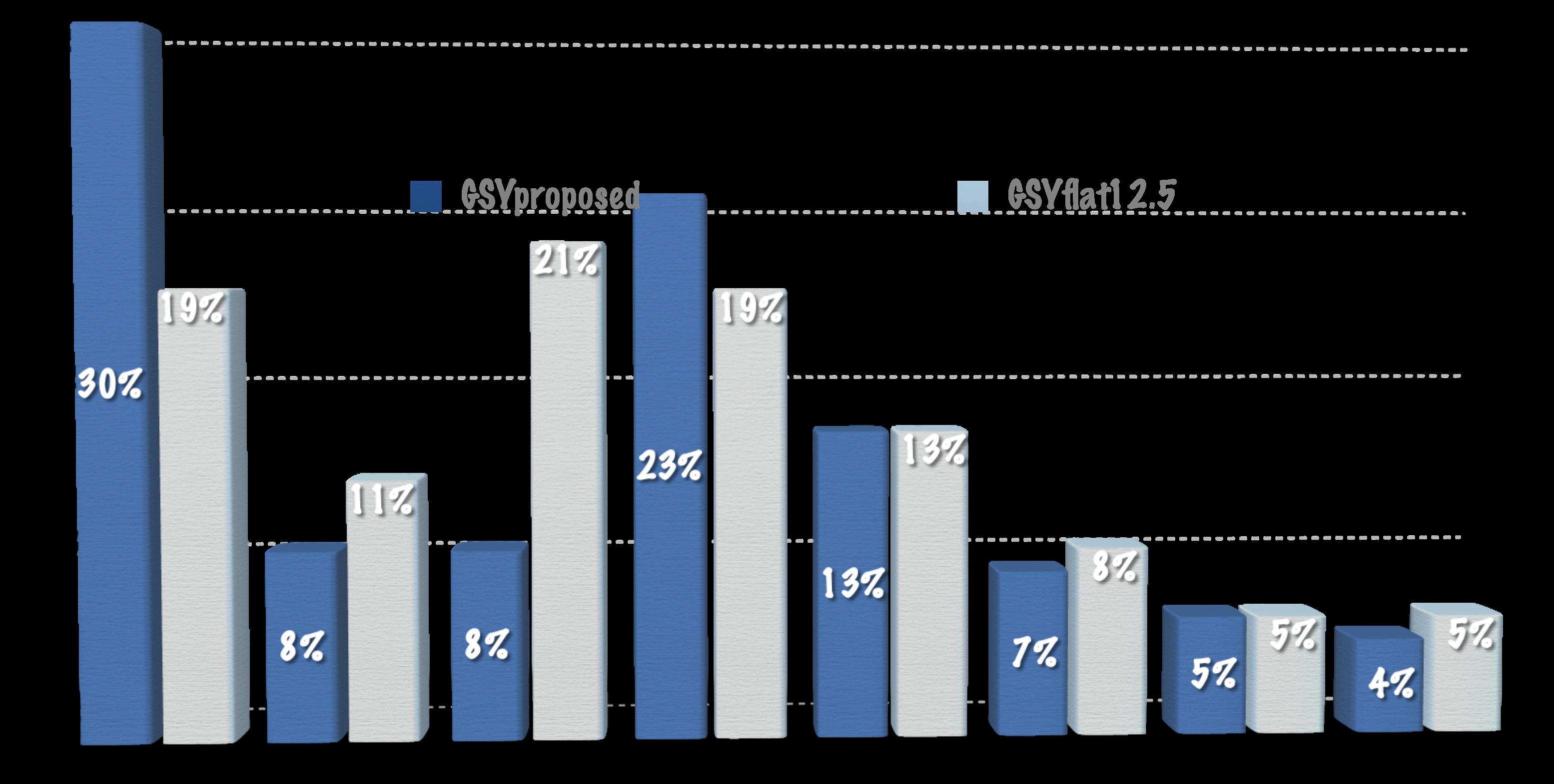
Social Security Funds surplus / (deficit) (£m) 66
Aggregate income (£m)* 948 765
Aggregate expenditure (£m)* (820) (818)
Aggregate surplus / (deficit) (£m)* 128 (53)
FLAT 12.5% REGIME 2021 Rate Revenues
Tax revenues (£m) 472

Personal income 290.3 12.5% 152
Corporate income 71.3 12.5% 89
Other taxes 110 110
Such work can be done. It is not an exercise that was achievable in the timeframe over the seasonal period.
Income tax of 12.5% would make the island very attractive to middle- and higher-income earners.
Lower employer social insurance would make reduce the costs to firms of employment
We have done the maths: using 2021 audited numbers, a flat rate of 12 5% generates the same revenues as the current regime
We make no attempt to provide a forensic distributional analysis. In the aggregate the burden on individuals is little changed We included a £10,000 allowance for social security contributions as well as income tax, so there will be a gain for those on lower levels of earned income
It is likely that the net gainers will be concentrated at higher income levels which would be beneficial to spending on items and activities more likely to boost the local economy
Operating income (£m) 64 64
Other corporate income (£m) 38 38
Further work would be needed to accurately calculate what the cost would be of the benefit increases to offset the initial increase in the price level. This would not take long. Our rough estimate is that the required sum is likely to be in the ballpark of £30m A manageable amount and not a dealbreaker for the approach
This analysis shows that the numbers add up for a flat tax regime. A few issues around the margin might require a rate that is a percentage point or two higher A rate of 14% would raise a further £90m, which we anticipate would cover the deficit position and increase in benefits
Social Security contributions income (£m) 191 12.5% 152
GST 12.5% 170
Aggregate income (£m)* 765
However, we would look to increased revenues from the introduction of a territorial corporate tax regime to avoid the contractionary impact of increasing the tax burden
The key factor for this regime, is less that the rate is flat but more that it is common to all taxation types This is the best safeguard against rates being raised in future Once jointly set they are very hard to change
Thus a flat tax regime establishes spending discipline.
it would also broaden the tax base (an objective of Guernsey's tax review) to a much greater degree than the proposals of Guernsey's Policy and Resources Committee.
A flat tax regime would be a major pro growth move boosting Guernsey's competitiveness........
It seems like ancient history now but, shortly after having introduced the Zero/10 regimes, in 2009 the EU's Code of Conduct Group on Business Tax determined that it would assess the corporate tax regimes of the Crown Dependencies on the presumption that they contained harmful measures
The approach of the three islands differed. Encouraged by the UK, Guernsey signalled its willingness to consider introduction of a territorial regime of corporate tax
During a 12 month period such a regime was developed6 and Guernsey was poised to announce its introduction with public support from the UK All technical difficulties that existed at that time were overcome.
However, during this period, Jersey and the IOM fought the Code Group and managed to secure a ruling that the zero/10 regimes were considered not to be harmful once the deemed distribution regime was removed This they promptly did Guernsey shelved its plans and followed suit
The first point to appreciate is that it was the working assumption of those involved at the time from all three islands that the zero/10 regime had a limited shelf life Of no more than ten years was the general refrain
The second point to appreciate is that much has changed in international corporate tax in the last decade Not only have substance rules been introduced (rules whose manner of implementation challenge national tax sovereignty), but the Global Agreement on the Two Pillar Solution to Address Tax Challenges Arising from Digitalisation of the Economy in 2021 effectively set the world on a path of an agreement to a national minimum level of corporate tax.
The technical development of a territorial regime today would be much harder though not impossible. Politically it would also be much harder. Territorial tax has lost some of the lustre it had ten years ago when the UK committed to incorporating elements of territorial tax in its own corporate tax regime The EU would presumably want to assess a new regime which would be a fraught process without the UK as a supportive member state.
Irrespective of these difficulties, the world is clearly moving to a global minimum rate of corporate tax and the Crown Dependencies need to quickly develop a roadmap to getting there
Having a general rate of zero creates a host of unnecessary antagonism from international tax activists
The dislike for Channel Islands it engenders in certain quarters is the root cause of much of the higher compliance costs of the finance sector Higher standards are applied to the Crown Dependencies because they are actively disliked

The accusations against offshore financial centres now include being the cause of global wealth inequality
An accusation The International Sustainability Institute debunked in a paper published just prior to Christmas 2022, 'Convenient Untruths, Exploring Global Fiscal Fallacies'
Having a normalised regime would thus be accompanied by many upsides. Reforming the corporate tax regime ought to be an urgent priority for the governments of all the Crown Dependencies7.
Guernsey has a large proportion of profits in its published GDP. The share of profits for the IOM is even higher. Bringing captives insurers in scope under a territorial regime of corporate tax would make the two more comparable and more significanlty could provide a significant and sustainable revenue stream
The $64m dollar question (or rather questions) is how much greater would the scope be and how much revenues would such a regime raise?
This isn't the paper to provide such details but we believe a few broad working assumptions can be applied.
There is an exemption for funds in the current tax regime. Such ringfencing is pretty common international practice. Managers and administrators already pay 10% tax on their profits. Little new revenue would materialise.
The banks are the original 10 of the zero/10 regime, paying 10% of profits derived from lending activities. Again little upside is likely.
It might go without saying, but it must be said, that retention of the tax neutral product is paramount. Passive income would therefore not be in scope for such a regime to preserve tax neutrality for clients of the trust sector. Little new revenue is likely to be raised there.
The insurance sector contains hundreds of captive vehicles that are Guernsey companies. It would be hard not to include these companies in scope of a territorial tax. As such this could provide a significant revenue stream.
There is debate as to the impact on the captive sector. The industry argument is that the zero rate is not material to jurisdictional choice But that is an easy argument to make if the question is merely theoretical There are a host of administrative and behavioural reasons that could mean it is material if the question is practical.

But if it were possible to make arrangements work the prize would be significant, easily generating a sufficient scale of revenue to fund the structural shortfall and pay for the benefit increases to support a 12.5% flat tax. Guernsey does not report or publish the profits of its captive sector Estimates can be generated with reference to published revenues and assumed rates of profit. For those that like a mental challenge we reproduce, using our estimates, the impact on the composition of Guernsey's GDP if captive companies were included in its calculation.
The IOM, which does include captive profits in its GDP is provided for comparison.

7Guernsey's
Application of a territorial tax could only apply where control of foreign company legislation such as that that applies in the UK and recognise the Guernsey regime for those purposes. This then enables tax to be netted off parent company taxation in the home jurisdiction to retain effective tax neutrality
ConclusionWe are convinced that the proposals of Guernsey's Policy and Resources Committee if approved, will in time lead to GST of 10%, possibly more, even if it is not the current intent.
The reasoning is simple Spending growth has outpaced economic growth for many years and these trends will continue if nothing is done about them widening the structural deficit.
Nothing in the tax review and the manner of its presentation suggests to us that anything will be done, nor that these issues have even been registered If the proposals are adopted the most likely outcome is a continuance of the present path and a near inevitability of GST of 10% by 2040.
Increasing costs of healthcare and pensions driven by unavoidable demographics will drive a requirement for increased spending. But the affordability of this is being undermined by continued weak economic growth.
In our view there is nothing proposals that will bring about an improvement in Guernsey's economic competitiveness that is needed to boost growth. However, there is an opportunity to improve competitiveness and help set Guernsey's economy on much needed higher growth path and put public finances back on a sustainable path
This tax review does provide an opportunity to radically restructure Guernsey s tax regime.

We propose a radical change to the personal tax regime alongside introducing a territorial regime for corporate tax. A radical change that does include GST. A radical change that would be a major pro-growth move. A regime where all major taxes, personal income, corporate income, social insurance, and GST are all set at the same rate
A flat tax regime.
Of 12.5%.
Alongside a territorial corporate tax regime.
We believe it is the only fiscal approach that has the potential to boost competitiveness and catalyse growth The key ingredient for long term fiscal sustainability.
Having demonstrated the numbers stack up for such a regime, we believe it would be prudent to review such an approach in more detail
If Guernsey's Parliament votes to pursue the introduction of GST at 5% without first making the commitment to review this approach we believe this opportunity for radical change will be lost
A flat tax regime would be a major 'pro-growth' move boosting Guernsey's competitiveness
.

The policy of the ISI is to set out a proposed research programme and invite support from individuals and firms sharing our philosophy and thoughts This can be found on our website The research programme of the ISI relies on patronage and sponsorship Commissions are accepted
Published research briefings outline our philosophy and thinking They also present our present and proposed programmes
Support for the programme or individual papers is welcomed Abstracts are available on request
In the first instance email contact@isici.org.
Founded by Dr Andy Sloan, the International Sustainability Institute, Channel Islands, was established to further the development of sustainable research and thought, advocating global fiscal, environmental and financial sustainability


The Institute provides a forum for the exchange and development of new ideas between stakeholders across the Channel Islands
The work of the Institute is concentrated in the key areas of fiscal and financial sustainability Areas where the Channel Islands have intellectual capital, natural resource, and professional expertise that can be harnessed in the pursuit of global good Through the development of a research and advisory programme, the Institute contributes to global thinking on policy in these key areas
It publishes a forward-looking schedule of planned research topics Its research programme is open to proposals, contributions, and commissions
The Institute also provides advocacy and advisory services Through a network of experts and researchers, and leveraging the expertise of its founder, it can draw on the experience of international policy work at the highest levels across sustainable finance, economics, tax and financial services regulation